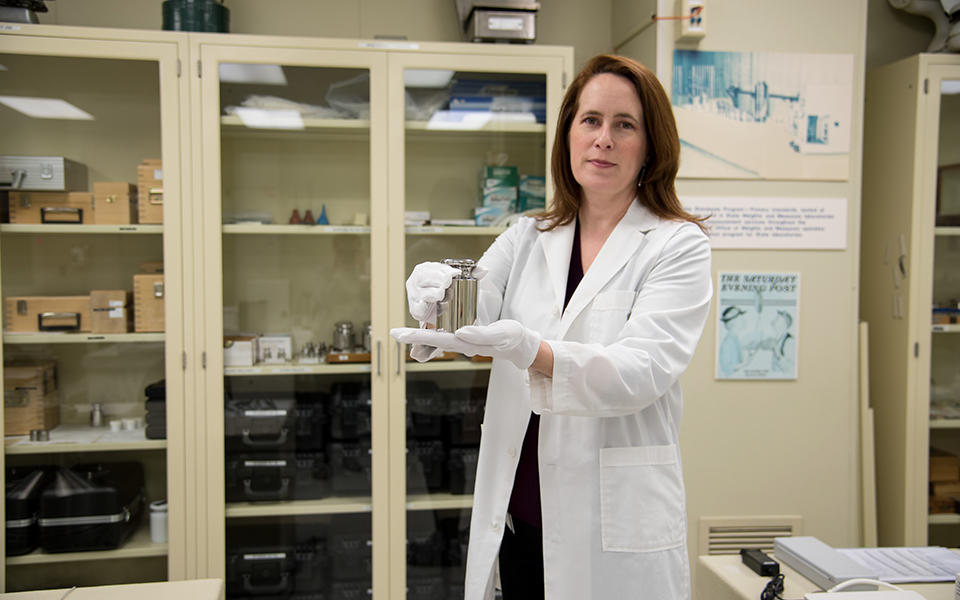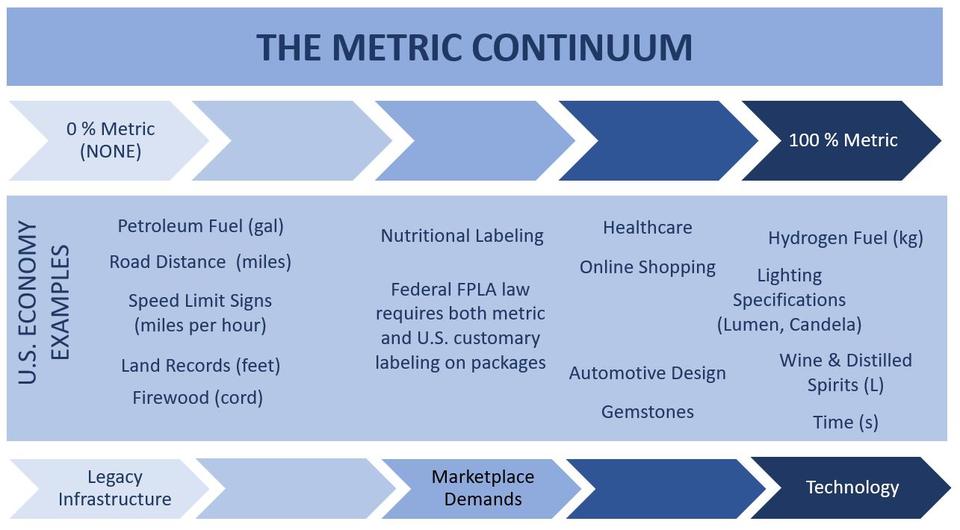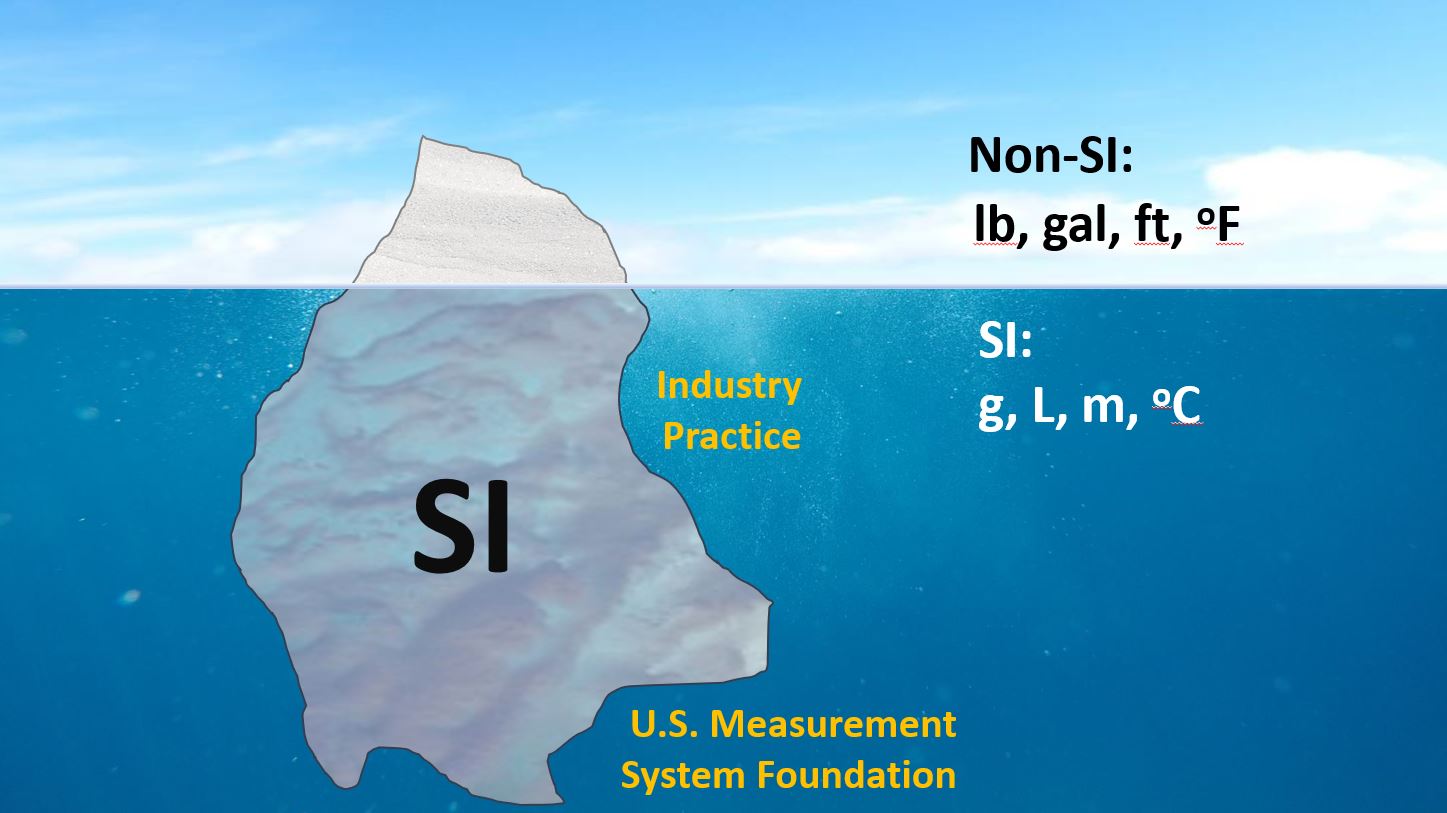Taking Measure
Just a Standard Blog

Elizabeth Benham and other NIST weights and measures metrologists train weights and measures inspectors from across the country to use standard weights like this to test measurement devices like grocery store scales for accuracy.
This year will be the 45th anniversary of the Metric Conversion Act, which was signed on December 23, 1975, by President Gerald R. Ford. Normally, we celebrate by sharing metric education resources, but this year I want to use the occasion to dispel some common misconceptions about the U.S. relationship with the metric system.
You’ve probably heard that the United States, Liberia, and Burma (aka Myanmar) are the only countries that don’t use the metric system (International System of Units or SI). You may have even seen a map that has been incriminatingly illustrated to show how they are out of step with the rest of the world.

It’s a compelling story and often repeated, but you might be surprised to learn that it’s simply untrue!
While it’s true that metric use is mandatory in some countries and voluntary in others, all countries have recognized and adopted the SI, including the United States.
Russ Rowlett, retired University of North Carolina at Chapel Hill professor of education and mathematics, emphasizes on his website that becoming metric is not a one-time event but a process that happens over time. Every international economy is positioned somewhere along a continuum moving toward increased SI use. There are still countries that are amending their national laws to adopt a mandatory metric policy and others pursuing voluntary metrication.
The United States was one of the original countries to sign the Treaty of the Meter in 1875, which is now celebrated annually on May 20, World Metrology Day. It’s been legal to use the metric system since 1866, and metric became the preferred system of weights and measures for U.S. trade and commerce in 1988.

Did you know?
- We use the SI every second of every day. After all, the second (s) is the SI base unit of time.
- U.S. coins & currency are produced using metric specifications.
- Many U.S. products, like wine and distilled spirits, have been successfully sold with only metric measures since the early 1980s.
- Metric units are used extensively on packages to provide net quantity, nutrition, and health-related information, and for prescription drugs, over-the-counter medicine, vitamin supplement dosing, and other consumer products.
- SI units are increasingly used on consumer product labeling in the U.S. lighting sector. Voluntary package labeling standards adopted by flashlight manufacturers help consumers make product comparisons. While shopping, consumers easily evaluate light output (lumen), peak beam intensity (candela), beam distance (meter), and impact resistance (meter).
It’s impossible to avoid using the metric system in the United States. All our measurement units, including U.S. customary units you’re familiar with (feet, pounds, gallons, Fahrenheit, etc.), are defined in terms of the SI—and mass, length, and volume have been defined in metric units since 1893! The SI’s influence is pervasive and felt even if most people don’t know it. I envision U.S. metric practice like a huge iceberg. Above the water’s surface, U.S. customary units appear to still be in full effect. In actuality, below the water’s surface, we find that all measurements are dependent on the SI, linked through an unbroken chain of traceable measurements.

Although U.S. customary units are still seen alongside metric units on product labels and merchandise literature, it’s common for the goods themselves to be made using SI-based manufacturing processes. Why? While some businesses are concerned that consumers expect to see customary units on the package, when it comes to manufacturing processes, they are under constant pressure to stay competitive. Adopting the latest science and technology, developed using metric design practices, enables innovation. In addition, many industries extensively use international supply lines to develop, manufacture and sell their products around the world.
I’m the coordinator of NIST’s Metric Program. Because of my passion for all things metric, I encourage companies to investigate adopting metric practices whenever possible and show them how doing so can make a strategic economic impact for their organization. Changes in technology and extremely competitive domestic and global marketplaces can compel businesses with little previous experience to explore metric use. Many have found that going metric pays off, resulting in a competitive advantage.
Going metric pays off
During the recent recession, lumber companies located in the U.S. Northwest saw their U.S. customer base shrink, but their Canadian and Japanese markets, both of which use metric, expand—especially after the 2011 earthquake and tsunami. Wood-product producers made adjustments so that their production systems could flex between metric and U.S. customary measures based on what their customers needed. Because so much of the world uses metric only, more and more U.S. companies are recognizing the benefits of metric as they find new international markets for their products.
If your business is considering making the switch to metric, I would encourage you to conduct small beta tests to explore how your customers react. Research can help ensure decisions aren’t based on out-of-date information or preconceived notions. You might be pleasantly surprised by how quickly customers adapt—and how using metric benefits the bottom line.
And as always, if you need advice, be sure to give NIST a call. We’re here to help!
*Editor's note: This post was updated on October 6, 2020, to include information about units of measure for lighting, to include a new "metric continuum" graphic, and to make other minor changes. It was originally published on December 23, 2016.
About the author
Related Posts
Comments
- Reply
This is one of the most educated and concise history of legacy units I've seen - It's appreciated. Yes, about 95% of the old imperial units were actually from the era when England was under imperial Roman rule. Oddly enough, even the Americans can lay claim to development of the metric system early on as both Franklin and Jefferson were Francophiles and history states that they actually assisted the French in it's development (America's metric currency system is a direct result). It is long overdue for a nation that regards itself as progressive and intelligent to be carrying along the baggage of antiquated and useless units of measure.
Although none of the modern measurement systems were invented in the U.S., our role as an original signatory to the Meter Convention established our commitment to improving measurements that’s guided the journey towards a coherent system based on fundamental constants, rather than barleycorns, Roman soldiers paces, or His Royal Highness’ body parts. The old British system was a hodgepodge of units, assembled from a variety of cultures and sources. U.S. colonists brought it here; but subsequent changes over time created additional differences between the British and U.S. Customary systems. But that’s another blog article! NIST HB 44 Appendix B (2.3) https://www.nist.gov/system/files/documents/2017/05/09/appb-14-hb44-fin…) explains how the U.S. Customary System differs from the British System. NIST SP 447 Weights and Measures Standards of the United States, A Brief History (https://www.nist.gov/sites/default/files/documents/pml/wmd/pubs/2010/12…) offers a more detailed explanation.
Fantastically well put and I could NOT agree more with your assessment. Thanks for finding the words I seem unable to express.
אני אוהב אותך!!!!!!!!!!!!!
Unfortunately, it will be extremely difficult to do, especially now. The US is already failing at getting large swaths of its population to understand: wearing masks prevents transmission of the corona virus, shooting unarmed citizens is wrong, and climate change is real caused by greenhouse gases.
The best way to do this is to pass a federal law banning the selling, advertising and the manufacture of all products using the imperial system, even if metric is specified along side it. Old stock products can still use the imperial system. The law should go into effect immediately starting with the federal government and its suppliers with a 2 year grace period for all private and public businesses. The penalty for using imperial would be an invalidation of any implied, verbal or written transaction or agreement with terms favoring the buyer. If consumers, for instance, are sold products in imperial, they are automatically entitled to keeping the product along with a full refund.
Johnathan, I'm afraid that would be unconstitutional per the 4th amendment and 1st amendment and probably other parts as well.
The fact is that the United States does use SI for science and industry. It's just daily life where we don't , and it's the result of choices that individuals make. We can't force people to use metric in every day life, come on now.
In Australia we were 'forced' when our government made a decision to go metric over 40 years ago. Isn't that what governments do? Make decisions for the benefit of the people?
That's preposterous. The 4th or 1st amendment doesn't guarantee an American the right to use imperial units. Ridiculous. Congress has express authority to set official weights and measures (US Constitution, Article I, section 8 gives Congress the power to fix the standard of weights and measurement.) If everything in the US wasn't politicized, we'd be much further along with metrication and wouldn't be the worlds' outlier weirdo, throwing wrenches in the machinery of the world by perpetuating antiquity.
Stan, good point. I often think about the roads we drive on. We don’t own those roads. The government could change the speed limit signs to km/h. However, if someone wants to place a sign on their personal property that says 10 mph they should have that right.
As a kid, I grew up overseas and never learned USCU until we moved back home when I started Highschool. The only thing that seemed totally ridiculous are fractional inches....how peculiar!
As a 70 year old retired engineer, unit conversions are simply annoying but not insurmountable. The only thing really annoying are fasteners and piping. Has anyone developed a handheld scanner that can quickly and accurately identify thread sizes. What is TOTALLY UNACCEPTABLE is the fact that some of the mechanics and craftsmen I hire will force incompatible threads, thus stripping them out...not worth a trip to the hardware store.
Sadly, I feel the only way to solve this dilemma is to stop teaching non-SI measurement in our schools, except perhaps a cursory mention in US History. It will clearly take a generation but we need to get started ASAP.
I support your words...we need the change wake up
I must ask - how on God's green earth do you think Americans somehow invented our goofy method of measure we cling to so dearly? A large portion of USCS are throwbacks from the Roman empire, the remaining are edict of a king (um, the 'foot' and the 12 inch 'ruler'). If we were being honest and fair, we would've abandoned imperial (English) units for French (our staunchest ally in the Revolutionary War) just out of principal on or about 1790, as intended. Now, SI is not bound to any one nation. The kg and the meter (metre) have all been redefined using constants from nature. It is truly a system for all mankind and it's time we adopt it.
The USA uses metric on the daily.
very intresting.
I don't know. I'm perfectly capable of using litres per 100km and I can figure out in my head how many more km's I can travel before running out of gas. It just took a little bit of flexing the brain muscles to acclimate to SI - but I'm in a small minority of Americans who seem to enjoy doing just that. On one hand, I'm glad I became fluent in SI on the other hand, being forced to use road signs in miles, feet and barleycorns makes me gag just a little bit knowing full well they'll never change. We are outliers here and we're rejecting what the rest of the world has acknowledged that SI is simply, unequivocally a superior way of measuring our world.
So you're staying in the 11th century because a modern, rational, universal system based on decimals isn't pithy enough? I'm sorry, but that is simply incomprehensibly short sighted.
You do realise that countries that have adopted metric still use most of those terms and phrases? No-one here in Australia says "your kilometers may vary". We still describe something a long way away as being "miles away", or moving forward slowly as "inching closer", or talk about someone putting on weight as "stacking on the pounds"... even though most Australian's under the age of 60 have no idea what a mile, inch or pound actually is.
Of course you don't realise that.... because you're an American and can't possibly conceive of how other parts of the world work.
JAnta, I have many friends and have had enjoyed conversing with many co-workers from around the world: from the UK, India, New Zealand, and many others countries, yes, even including that wonderful country/continent of yours, Australia! G'day, mate! I'm American, almost 60, and while I am absolutely proud to be an American, I don't carry with that pride any sense of one-upmanship, or looking down on anyone else from any other country. It's a shame, really, that so many of us Americans get a bad reputation, without cause, because... perhaps a negative encounter with someone else, or perhaps just a preconceived notion that paints all Americans with the same awful brush. I loved it when co-workers would bring in sweets from their travels home to India, or teach me some of the colloquialisms from England, Australia, etc! I LOVE learning about other countries, and have done so since I was in high school in the early 1980s! Please don't discount all Americans! I agree that there are some 'ugly Americans' just as there are some 'ugly' acting people in every country on the face of the earth... because people are people!
The correct phrase would be "your kilometers may vary", otherwise it should also be "your mileage/hour may vary"
The map is accurate visualization of the commonly accepted senses of units by country. For example, those people in the three countries do not easily understand how long a 1-m stick is in general. Although SI is used in very limited areas by scientists and engineers, it does not mean the unit is accepted in the country. There are only two type of people; who tell their weights in kg, and those who use their traditional unit. There is no gray area in between them. The metrification continuum is a total myth. Go outside your country and see what other people do, because that is the only way to find out how absurd this article is.
Although the “metric map” has been elevated to a pop culture meme on the internet, it’s based on out-of-date information. This metric myth is rooted in an early map published in the 1971 U.S. Metric Study that depicted countries “uncommitted” to mandatory metrication. To see the historic map, visit the NIST U.S. Metrication FAQ website. Over the years, the term “uncommitted countries” has morphed into “non-metric” countries, a depiction that’s been used to criticize voluntary metrication by the United States.
If i ever start a business I will look into using the metric system. It look like i will make some money since it is no way around using the metric system everyday.
A nation of pig headed, recalcitrant citizens who for the most part seem blissfully unaware that any part of the globe exists but themselves. I feel terrible for kids in schools today. Especially those who may be inspired to join the scientific world. They claim they're teaching SI in American schools but the disconnected, chaotic 'real world' pressure of kings feet, barleycorns and Roman soldiers makes them soon forget what they've learned. Retaining our impractical, insular method of measure here in the US is a clear detriment to the future of our kids and their offspring. It is a foolish, quaint mish-mosh of nonsense. I'm in my 50's and still cannot conceptualize a "floz" vs an "oz", 12th, 8ths, 16th, 32nds of "inches", teaspoons, tblsp's, etc. It's absolutely confounding when you step back and objectively analyze it. I just use it because I am forced by American society to do so. I'm not overstating when I suggest that my own personal failure in the American education system was, at least in part, due to trying to grasp obtuse concepts like "American units" and relate them to each other. It's just not possible.
Absolutely brilliant summation of the situation. I always use metric to describe my height “193cms. And for those of you who don’t use metric… we wish you would.”
1cm cubed of water is 1 gram and it takes 1 calorie to raise the temp of it by 1 degree C. Therefore 100 calories to turn ice into steam.
You also need to overcome the latent of turning ice into water, and water into steam. That would be 540 calories.
Both Myanmar and Liberia have made a decision to adopt the SI Metric System. The USA is literally alone as the only country on the planet Earth not making a serious effort to go metric.
The metric system is very good because when you are cooking you can use it to distrubute your ingredeints
I'm confused by the fact that you "updated" a 4-year old article and presented it as new. What were the updates? Seems to contradict a blog that respects standards. Journalistic standards, not so much.
Resistance to change is part of every human's DNA. It is part of what makes humans human. Some are more resistant than others. There isn't a right or wrong about the balance. There are several well documented reasons why people resist change.
(1) Complacency such as inertia or maintaining status quo
(2) Resignation such as anxiety the change is not an improvement and is viewed as a personal failure, or
(3) Cynicism or expectation the change result is not an improvement and viewed as someone else failing
Most resistance to change is rooted in Complacency. And most intentional progress is derived from organized efforts to overcome the complacent.
To the good people at NIST - don't get discouraged by those expecting failure. Work through complacency, gun your change engines, and get your KPH to a high rate of travel! :-)
Well said!
Its 2020 and we still have huge differences in what should be a common understanding of measurement systems. Invisible borders is what halts our progress into the future.
One important field of activities extending worldwide - aviation, was not mentioned. No problem making the conversion here either. I have been flying (lawful) my glider in the US since 1996. All instruments are S.I. - Altimeter (m), ASI (kilometers/hour), variometer (M/s), etc. My flights are all VMC (Visual Meteorological Conditions) and I can't maintain a level as the IMC (Instrument Met. Conditions) like the big guys. This is adjustable and can be done. It will take time and money (many instruments) and reeducation, but it is doable. Time to start, like everything else..
By the way, I am very proud of my two 750Km (454.545mi) flights.
One important field of activities extending worldwide - aviation, was not mentioned. No problem making the conversion here either. I have been flying (lawful) my glider in the US since 1996. All instruments are S.I. - Altimeter (m), ASI (kilometers/hour), variometer (M/s), etc. My flights are all VMC (Visual Meteorological Conditions) and I can't maintain a level as the IMC (Instrument Met. Conditions) like the big guys. This is adjustable and can be done. It will take time and money (many instruments) and reeducation, but it is doable. Time to start, like everything else..
By the way, I am very proud of my two 750Km (454.545mi) flights.
A metric altimeter? That's odd, given that everyone except China and North Korea uses feet for altitude. Even the Russians, who stopped using meters a few years ago, use feet. Nautical miles are used for ground distance. Aviation uses a ton of non-metric units and doesn't seem interested in stopping.
Sailplane instruments have always been metric and remain so to this day.
Airplanes flying over Russia use Flight Levels based on feet, FL300 is 30000 feet using a standard altimeter setting. Down lower in Russia you change to metre altitude, metres per second wind speed and all Russian speeds in aircraft are in km/h. altimeter settings are in hectopascals.
Time is not measured metrically. I have spent 49 years (omg almost 50 years now) as a metrology technician. 99 percent of my work still to this day is done in pounds, ounces, foot pounds, inch pounds, gallons quarts, etc. only electrical units of measure have been adopted as standards in use for my customers. Until the day we rework the day into 100 (some measurement unit) we will never be able to convert Time to a metric unit. This old man still prefers to use non metric units.
I cannot visualize metric units and must convert them to the measuring system that I grew up with before I know what the given measurements actually mean. I know that metric measures are useful and more precise, but they are of no use to me.
I was a child during the push to switch over to Metric and I can say one of the biggest mistakes was why the emphasis on converting back and forth! Fortunately, my time card in the military Metric is widely used and once I realized that if it is in Metric there's no need to convert! Also, I did a lot of traveling, abroad so the Metric System is natural to me. I use it whenever possible. My GPS I use Metric, phone temp Celsius, even my car most of the settings are set on Metric! I'm actually embarrassed that we are so slow with the changing, most people abroad look at us like we're idiots. At least I know the younger generations are being taught Metric properly,and most agree we should be using it. It's past time, and it's mainly the baby boomer generation that refuse to adapt, to change.
Nice try but the vast majority of Americans have no clue on metric. For example, they don't even know how far a kilometer is compared with a mile.
Interestingly, the British still officially use miles for road signs. But the younger generations think almost exclusively in metric, since that's what the state schools and NHS teach/use. Stones and pounds for a person's weight, and feet and inches for a person's height, are only used in everyday parlance among older generations.
Although Canada adopted SI on April 1, 1975 (to some hatdcore Canadians this was indeed a joke) we still use Imperial measures widely, in fact exclusively in construction and plumbing. In western Canada temperatures are still announced in F and C in medias. Elders tend to state distances in miles although our maps and traffic signs are exclusively metric. SUMMARY: Canada still uses, albeit unofficially, Imperial measures.





